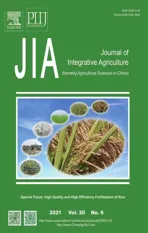Effects of 105 traditional Chinese medicines on the detection ofβ-agonists in medicine extracts and swine urine based on colloidal gold immunochromatographic assay
2021-05-23WANGZilinFENGKeyingGEXiufengMAlJiachengWANGHanchuanLlUWenziZHANGJiahuiSHENXiangguang
WANG Zi-lin,FENG Ke-ying,GE Xiu-feng,MAl Jia-cheng,WANG Han-chuan,LlU Wen-zi,ZHANG Jia-hui,SHEN Xiang-guang
1 Guangdong Provincial Key Laboratory of Veterinary Pharmaceutics Development and Safety Evaluation,South China Agricultural University,Guangzhou 510642,P.R.China
2 Animal and Poultry Products Quality Control,Inspection and Testing Center,Ministry of Agriculture and Rural Affairs,Guangzhou 510642,P.R.China
Abstract Colloidal gold immunochromatographic assay (CGIA) is commonly used for the on-site detection of β-agonists that are sometimes used illegally as feed additives in swine diets. However,few studies have evaluated the causes of false-positive results that sometimes occur when applying CGIA in agricultural settings. In this study,we investigated if this false-positive phenomenon is related to the addition of certain traditional Chinese medicines (TCMs) to swine feed. We established and verified an extraction method for TCMs,and then applied CGIA to detect β-agonists in the extracts of 105 TCMs and in the urine of swine dosed with TCMs,respectively. Liquid chromatography-tandem mass spectrometry was used to validate the results of the urine samples tested positive for β-agonists using CGIA. The results were also verified using TCMs and colloidal gold test strips produced by different manufacturers. The extracts of Citri Reticulatae Pericarpium Viride,Citri Reticulatae Pericarpium,Magnoliae Officinalis Cortex,Chaenomelis Fructus,and Rhodiolae Crenulatae Radix Et Rhizoma were tested positive for β-agonists. Meanwhile,the addition of Citri Reticulatae Pericarpium Viride and Citri Reticulatae Pericarpium to swine feed resulted in false-positive results for β-agonists in swine urine. The results provide a new way to explain false-positive CGIA results and provide valuable information for livestock feeding programs.
Keywords:colloidal gold immunochromatographic assay,false positive,traditional Chinese medicine,β-agonists,swine urine
1.lntroduction
Food safety is a primary concern worldwide. Over 250 foodborne diseases may be passed on to humansviaphysical,chemical,and biological agents (Khanet al.2017).Food safety problems arising from β-agonists have attracted increasing societal attention. β-Agonists are normally used to treat pulmonary diseases such as asthma and bronchospasm. However,at doses five to ten times above the therapeutic level (Penget al.2017;Kabirazet al.2018),β-agonists cause adverse side effects (Donget al.2019)such as metabolic disorders,fatigue,dizziness,arrhythmia,and even cancers along with diseases of central nervous and cardiovascular systems (Simonet al.2018). Due to their ability to improve muscle growth and fat lipolysis in high doses (Feddernet al.2018;Huanget al.2018;Chenget al.2019),β-agonists are sometimes used as illegal feed additives to increase econmoic profit of producing edible livestock such as swine (Zhuet al.2017). β-Agonists are banned as growth promoters in approximately 160 countries,including China,European Union countries,and Russia(Helduret al.2016). However,the problems caused by β-agonists have not been completely solved,and thus a new rectification program targeted at β-agonists has been implemented in China since 2019 (MARAPRC 2019).Clenbuterol (CLB),ractopamine (RAC),and salbutamol(SAL) are the three most commonly encountered β-agonists in swine.
Numerous mature techniques for β-agonist detection are available,including colloidal gold immunochromatographic assay (CGIA),radio-immunoassay,enzyme-linked immunosorbent assay,biosensors (Karamolegouet al.2018),gas chromatography combined with mass spectrometry,and liquid chromatography-tandem mass spectrometry (LC-MS)(Zhanget al.2016). CGIA is widely used by inspectors of agricultural facilities,because of its convenience,ease of use,low cost,and suitability forin situdetermination(Zhanget al.2018). CGIA is based on competitive immunochromatography;that is,the target substance in the detected liquid generates an antigen–antibody reaction with colloidal gold to form antigen–antibody compounds.
To legally improve the economic return of edible livestock,many breeders use traditional Chinese medicine (TCM)preparations or powders to prevent livestock disease. For instance,a compound preperation containing Codonopsis Radix can boost immunity against blue ear virus and accelerate growth (Liuet al.2019). A TCM preparation containing Artemisiae Annuae Herba,Dichroae Radix,and Sophorae Flavescentis can effectively preventEimeria tenellainfection in chicken (Raoet al.2018). A superfine compound powder of TCMs was shown to improve growth performance and immune function in weaned piglets (Li 2018). However,qualities of TCMs are difficult to evaluate due to a lack of governmental standards (Liuet al.2016).Therefore,non-standard TCM formulations and doses may still be used in clinical applications. In this study,we propose and confirm a theory that false-positive CGIA results for CLB,RAC,and SAL are related to the addition of TCMs into swine feed. To test the theory,105 commonly used TCMs,as indicated in theVeterinary Pharmacopoeia of the People’s Republic of China(VAPC 2015),were chosen as experimental TCMs in this study.
This study was designed to identify the TCMs that may cause false-positive CGIA results for CLB,RAC,and SAL.The CGIA results were validated by LC-MS. The findings are valuable for developing livestock feeding programs,enhancing the efficacy ofin situβ-agonist detection,and improving the meat industry.
2.Materials and methods
2.1.Preparation of reagents
Stock solutions of CLB,RAC,and SAL (Shanghai Ambrosia Pharmaceutical Co.,Ltd.,China) were prepared and stored at -18°C. A mixed standard working solution containing 0.06 μg mL–1CLB,0.1 μg mL–1RAC and 0.1 μg mL–1SAL was then prepared by diluting the stock solutions with methanol (Thermo Fisher Scientific Inc.,Norway).Phosphate buffered saline (PBS,pH=7.4) was prepared by adding 1.36 g potassium phosphate monobasic (DaMao Chemical Reagent Factory,Tianjin,China) to 79 mL of 0.1 mol L–1sodium hydroxide (Guangzhou Chemical Reagent Factory,Guangzhou,China) solution,and being diluted to 200 mL with ultrapure water (Advanced-II-12,Chengdu Tangshi Kangning Science Development Co.,Ltd.,Chengdu,China). Formic acid-acetonitrile solution(0.1%) was prepared by adding 0.5 mL of high-performance liquid chromatography (HPLC)-grade formic acid (Thermo Fisher Scientific Inc.) to 500 mL of HPLC-grade acetonitrile(Thermo Fisher Scientific Inc.). Formic acid-ultrapure water(0.1%) was prepared by adding 0.5 mL HPLC-grade formic acid (Thermo Fisher Scientific Inc.) to 500 mL ultrapure water (Advanced-II-12,Chengdu Tangshi Kangning Science Development Co.,Ltd.).
2.2.Evaluating the interference of 105 TCMs on the CGlA screening of three β-agonists
Establish a method to extract TCMsLonicerae japonicae Flos,Forsythiae Fructus,Taraxaci Herba,Glycyrrhizae Radix Et Rhizoma,Lophatheri Herba,Menthae Haplocalycis Herba,Arctii Fructus,Hordei Fructus Germinatus,Drynariae Rhizoma,and Platycodonis Radix were randomly selected from the 105 single TCMs (Guangzhou Nanbeihang Chinese Herb Slice Co.,Ltd.,China) used in this study and individually pulverized and used to create 10 quality control (QC) samples and 10 blank control (BC) samples.Each QC sample was prepared by adding 100 μL of mixed standard working solution to 2 g of single TCM. Each BC sample was only 2 g of single TCM. The QC samples were allowed to stand for 30 min after their preparation.Subsequently,the QC and BC samples were separately added to HPLC-grade acetonitrile and analytical reagent(AR)-grade ethanol (Guangzhou Chemical Reagent Factory,Guangzhou,China) in volume ratios of 0:10,1:9,2:8,3:7,4:6,5:5,6:4,7:3,8:2,9:1,and 10:0. The volume of each sample was 10 mL. The samples were then vibrated for 10 min before extraction in an ultrasonic bath for 3 min at 40°C and centrifugation at 2 800×g for 5 min. Supernatant(5 mL) from each sample was driedviareduced-pressure distillation at 45°C,and 1 mL PBS was applied to redissolve the sample. After a simple sensitivity determination using colloidal gold test strips purchased from Kwinbon (Beijing Kwinbon Biotechnology Co.,Ltd.,Beijing,China),these strips were used to detect redissolved fluids. Two replicates were performed for each sample.
Screening and detection of 105 TCM extractsAfter determining the optimal volume ratio for extraction,105 TCMs were extracted using the method specified above.Colloidal gold test strips were used to detect the redissolved fluids. Two replicates were performed for each sample.
Verification of the TCM extraction methodThe TCM extraction method was verified using another 10 random TCMs (excluding those used to establish the extraction method) that had negative gold strip test results. After grinding the 10 TCMs into powders,the optimal extraction volume ratio was verified using the extraction steps described above. QC and BC samples were made for each TCM.Colloidal gold test strips purchased from Dien (Zhejiang Dien Bio-Scitech Co.,Ltd.,Zhejiang,China) were used for detection. Two replicates were performed for each sample.
2.3.Verification of TCMs with positive CGlA results
This verification was performed using TCMs (Guangdong Shizhen pharmaceutical Co.Ltd.,Guangzhou,China) with positive gold strip test results. The TCMs were ground into powders and processed using the optimal TCM extraction ratio. Colloidal gold test strips purchased from Dien were used for detection. Two replicates were performed for each sample.
2.4.Feeding ternary pigs with 105 TCMs and testing swine urine with CGlA and LC-MS
This experiment was conducted at Guangzhou Fine Breed Swine Farm in Guangzhou,China. Ternary pigs (a species of swine) with similar weights and good health were selected and divided into two parallel experimental groups,each containing seven pigs,and a control group with three pigs. Ternary pigs from the control group were fed with only fodder. Each pig received 50 g of single TCM powder once a day for three consecutive days. If the pig urine did not test positive for any of the three β-agonists based on CGIA,the TCM was switched to another TCM. The pigs whose urine tested positive for β-agonists were no longer used in additional TCM experiments. All TCM powders were made into pastes by adding a bit of water to ensure TCM intake,and all pigs had free access to water. The urine samples were collected 6 h after TCM dosing each day and tested with colloidal gold strips obtained from Kwinbon.The urine samples with positive CGIA results were further examined by LC-MS using Agilent 1290 Infinity II (Agilent Technologies,Inc.,California,USA) and Agilent 6470 Triple Quad LC/MS (Agilent Technologies,Inc.,California,USA)instruments following the Ministry of Agriculture and Rural Affairs of the People’s Republic of China (1025-11-2008)(MARAPRC 2008).
3.Results
3.1.Optimal extraction ratio
The volume ratio of ethyl alcohol to acetonitrile during extraction affect the detection of CLB,RAC,and SAL in the extracts based on the coloration of the CGIA control and test lines. For the BC samples,at volume ratios of 0:10,1:9,and 2:8,the CLB,RAC,and SAL detections were all negative. For the QC samples,all three types of colloidal gold test strips showed that CLB tested positive at extraction ratios of 0:10,1:9,or 2:8 among all the 11 extraction ratios.However,the coloration of the test lines in the RAC and SAL test strips was weaker for the 2:8 ratio compared to the 0:10 and 1:9 ratios. Thus,an extraction volume ratio of 1:9 was applied in subsequent experiments in this study.
3.2.CGlA analysis of 105 TCM extracts
Table 1 shows the CGIA results for the 105 TCMs. Five TCMs (Citri Reticulatae Pericarpium Viride,Citri Reticulatae Pericarpium,Magnoliae Officinalis Cortex,Chaenomelis Fructus,and Rhodiolae Crenulatae Radix Et Rhizoma)showed a positive result for at least one of the three β-agonists,while the other TCMs had completely negative results. The detection outcomes differed among the five positive TCMs (Table 2). Citri Reticulatae Pericarpium Viride and Citri Reticulatae Pericarpium resulted in positive tests for CLB and RAC,Chaenomelis Fructus and Rhodiolae Crenulatae Radix Et Rhizoma for RAC and SAL,and Magnoliae Officinalis Cortex for only CLB.
3.3.Verification of the extraction method
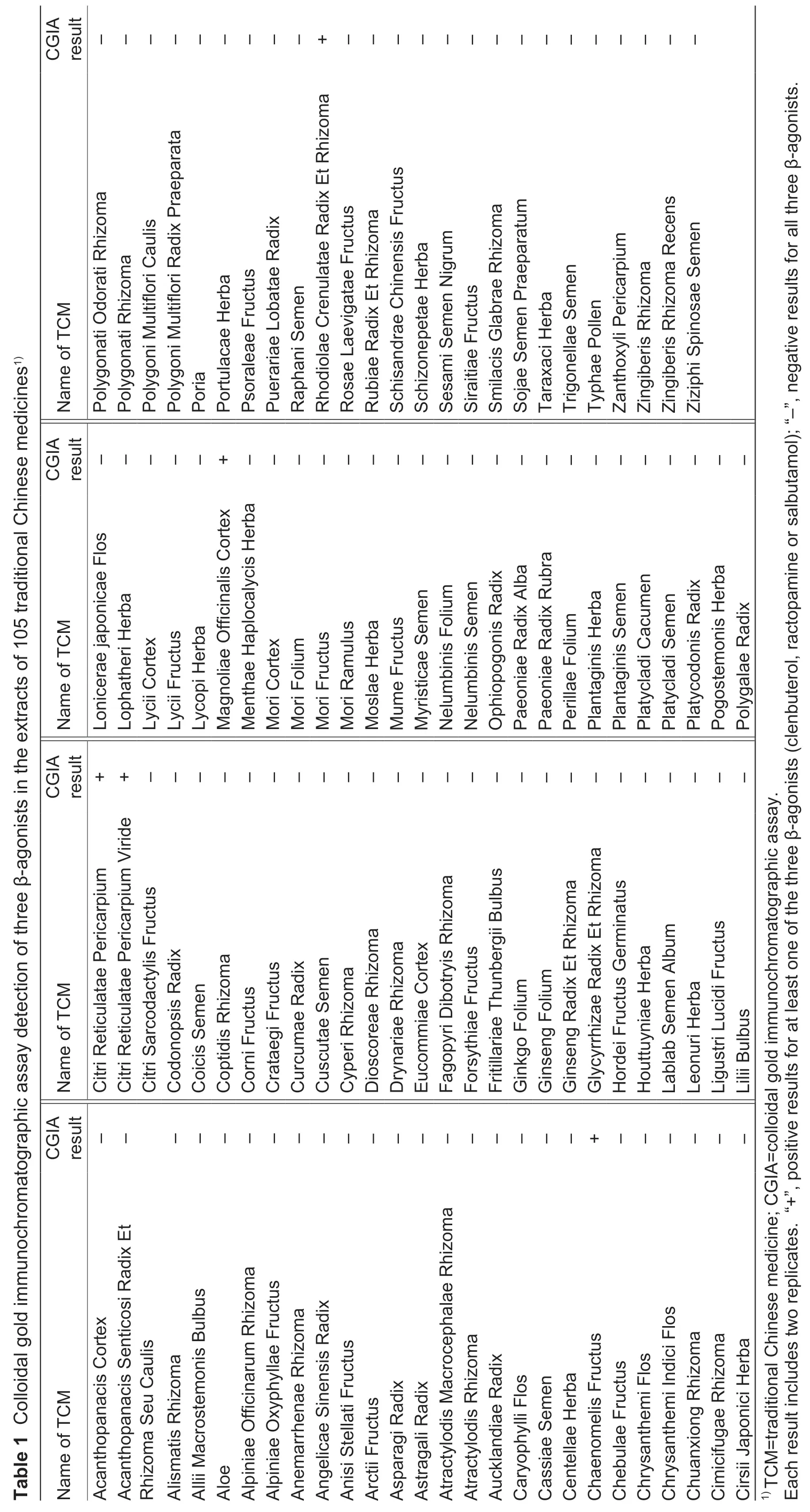
Nelumbins Semen,Centellae Herba,Chrysanthemi Flos,Lilii Bulbus,Corni Fructus,Curcumae Radix,Poria,Lycii Fructus,Fritillariae Thunbergii Bulbus,and Nelumbinis Folium were randomly selected to prepare the QC and BC samples. All CGIA results of the QC samples using colloidal gold strips from Dien were positive. For the BC samples,the tests were negative for all three β-agonists. The results indicate that the extraction method was suitable for this study.
3.4.Verification of five TCMs
As shown in Table 3,Citri Reticulatae Pericarpium Viride and Citri Reticulatae Pericarpium resulted in positive tests for all three β-agonists. Rhodiolae Crenulatae Radix Et Rhizoma and Magnoliae Officinalis Cortex generated positive tests for RAC and negative tests for CLB and SAL.Chaenomelis Fructus produced a negative SAL result and positive CLB and RAC results. These results demonstrate that Citri Reticulatae Pericarpium Viride,Citri Reticulatae Pericarpium,Magnoliae Officinalis Cortex,Chaenomelis Fructus,and Rhodiolae Crenulatae Radix Et Rhizoma from another manufacturer also resulted in positive CGIA test results.
3.5.Swine urine detection by CGlA and LC-MS
Swine urine was evaluated by CGIA immediately after urination. As shown in Table 4,for the TCMs with extracts producing negative results,the urine results were negative after TCM dosing.They still tested negative after applying Magnoliae Officinalis Cortex,Chaenomelis Fructus,and Rhodiolae Crenulatae Radix Et Rhizoma. The urine tests were positive for RAC after dosing with Citri Reticulatae Pericarpium Viride and Citri Reticulatae Pericarpium (Table 5),which was validated by LC-MS. As shown in Figs.1 and 2,the urines containing the metabolites of Citri Reticulatae Pericarpium Viride and Citri Reticulatae Pericarpium did not produce chromatographic peaks. Thus,the combined CGIA and LCMS results indicate that Citri Reticulatae Pericarpium Viride and Citri Reticulatae Pericarpium can cause false-positive results in CGIA determination of swine urine.
4.Discussion
4.1.Application of multiple gold strips
Colloidal gold test strips from different manufacturers may produce difference CGIA results,due to the variations in scientific technology and product quality requirements among manufacturers. This study used colloidal gold test strips from five manufacturers to confirm positive CGIA results.They are Kwinbon,Dien and three additional manufacturers,Sanfangyuan (Shenzhen Sanfangyuan Biotechnology Co.,Ltd.,Shenzhen,China),Puzan (Beijing Puzan Biotechnology Co.,Ltd.,Beijing,China),and Green Spring (Shenzhen Green Spring Biotechnology Co.,Ltd.,Shenzhen,China). The results indicate that the manufacturer of colloidal gold test strips did not affect test outcomes;Citri Reticulatae Pericarpium Viride,Citri Reticulatae Pericarpium,Magnoliae Officinalis Cortex,Chaenomelis Fructus,and Rhodiolae Crenulatae Radix Et Rhizoma generated positive CGIA resultsin vitro(TCM extracts),while Citri Reticulatae Pericarpium Viride and Citri Reticulatae Pericarpium produced positive CGIA resultsin vivo(swine urine).
4.2.Optimal extraction method
Numerous methods are available for TCM extraction,including ultrasonic-assisted enzymatic extraction (Zhouet al.2018) and microwave-assisted extraction (Chen 2018). Our new extraction method uses a mixture of ethyl alcohol and acetonitrile as an extracting solution based on the characteristics of CLB,RAC,and SAL. This extraction method is fast,simple,convenient,and meets the needs of this study. However,further confirmation is needed to determine if this method is suitable for other experiments.In this study,the optimal volume ratio of ethyl alcohol to acetonitrile was determined to be 1:9. This ratio resulted in low lipid extraction,which minimized the interference of the redissolved fluid’s reaction with the gold strips and thereby ensured an effective CGIA determination.
4.3.Traditional Chinese medicine
Veterinary drug residues are known as an important cause of food safety problems (Zhaoet al.2018). Using urine and feces of veterinary antibiotics-fed livestock as organic fertilizer can lead to environmental contamination(Wollenbergeret al.2000;Kimet al.2011). TCMs have been used for over 1 000 years (Wang Cet al.2018;Zhu and Yu 2018) and have the advantages of low toxicity (Zhouet al.2017),low side effects,low probability of bacterial drugresistance,and short withdrawal time (Yanet al.2017). People accept TCMs because of their perceived high levels of efficacy and safety (Tsaiet al.2016).However,TCMs have complex compositions and irregular qualities (Wang Jet al.2018).In addition,TCM composition may be affected by production area,production time,and processing method. Hence,the different results obtained in our verification experiments can be attributed to different TCM manufacturers. Some extracts(e.g.,Chaenomelis Fructus)have low pH,resulting in invalid CGIA results;in this case,the pH of the test fluid should be adjusted to~7 with sodium bicarbonate.

Table 2 Breakdown of colloidal gold immunochromatographic assay results for the five traditional Chinese medicines that tested positive for at least one β-agonist

Table 3 Verification of the colloidal gold immunochromatographic assay results for the five traditional Chinese medicines that tested positive for at least one β-agonist
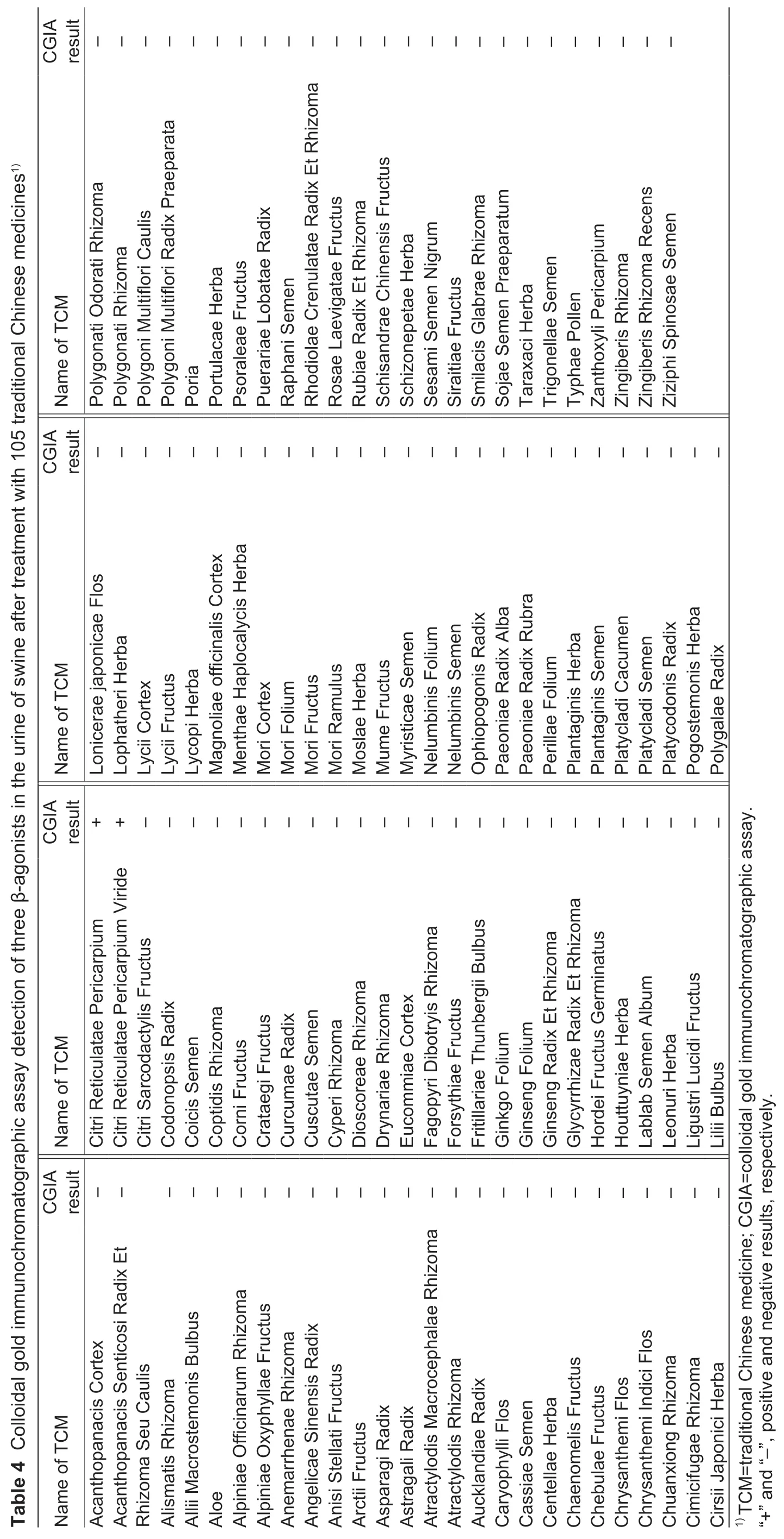
4.4.Animal experiment
In the animal experiment,a cage was prepared for each pig.The five TCMs that produced positive CGIA resultsin vitrowere added to pig feed at last(after the pigs were dosed with all the other 100 TCMs).To avoid contamination,urine was collected with plastic trays placed under the cages.The dose of TCM that led to false-positive CGIA results in pig urine was related to pig weight and breed. This study used ternary pigs with weights of approximately 35 kg,and the TCM intake reached 50 g per meal. After dosing with Citri Reticulatae Pericarpium Viride and Citri Reticulatae Pericarpium,the urine collected after 24 h had no positive CGIA outcomes,indicating that the withdrawal times of these TCMs were less than 24 h.
4.5.Effect of synephrine on CGlA test results
Synephrine (SYN),an active substance extracted fromCitrus aurantium(CA) that can increase fat oxidation inside the body without distinct side effects,had gained attention since the Food and Drug Administration prohibited the use of ephedrine alkaloids in 2004 (Peteret al.2017). SYN results in vasoconstriction,blood pressure elevation,and bronchial muscle relaxation (Kusuet al.1996) and has recently emerged as a weight-loss supplement worldwide.SYN is an alkaloid with a chemical structure (Fig.3) and properties similar to those of β-receptor agonists. Hence,a few follow-up experiments were conducted to determine the effect of SYN on CGIA detection of β-agonists in swine urine after pigs were dosed with Citri Reticulatae Pericarpium Viride and Citri Reticulatae Pericarpium,both of which belong to CA genus.
After dosing with Citri Reticulatae Pericarpium Viride or Citri Reticulatae Pericarpium at 50 g per day,the SYN concentration in swine urine was approximately 0.1 μg mL–1. It should be noted that this concentration may differamong the manufacturers of colloidal gold test strip. In summary,SYN might affect the outcomes of CGIA detection of CLB,RAC and SAL. Further study is needed to identify other substances that can affect the on-site detection of β-agonists.

Table 5 Breakdown of colloidal gold immunochromatographic assay results for the urine of swine that tested positive for at least one β-agonist
4.6.Difference between in vitro and in vivo CGIA test results
In this study,Citri Reticulatae Pericarpium Viride and Citri Reticulatae Pericarpium both generated positive CGIA test resultsin vitro(TCM extracts) andin vivo(swine urine).Magnoliae Officinalis Cortex,Chaenomelis Fructus,and Rhodiolae Crenulatae Radix Et Rhizoma presented differentin vitroandin vivoCGIA results,with the former being positive while the latter negative. This phenomenon may indicate that some substances contained in Magnoliae Officinalis Cortex,Chaenomelis Fructus,and Rhodiolae Crenulatae Radix Et Rhizoma have similar chemical structures to β-agonists and can react with colloidal gold pads. These substances may be metabolized to different substancesin vivoby swine,resulting in negative CGIA results. Another possibility is that the concentrations of these substances decreased to below the detection limit of the gold strips after thein vivoexperiment. Since TCM metabolismin vivois complex,more tests should be conducted to verify the observed phenomenon.
5.Conclusion
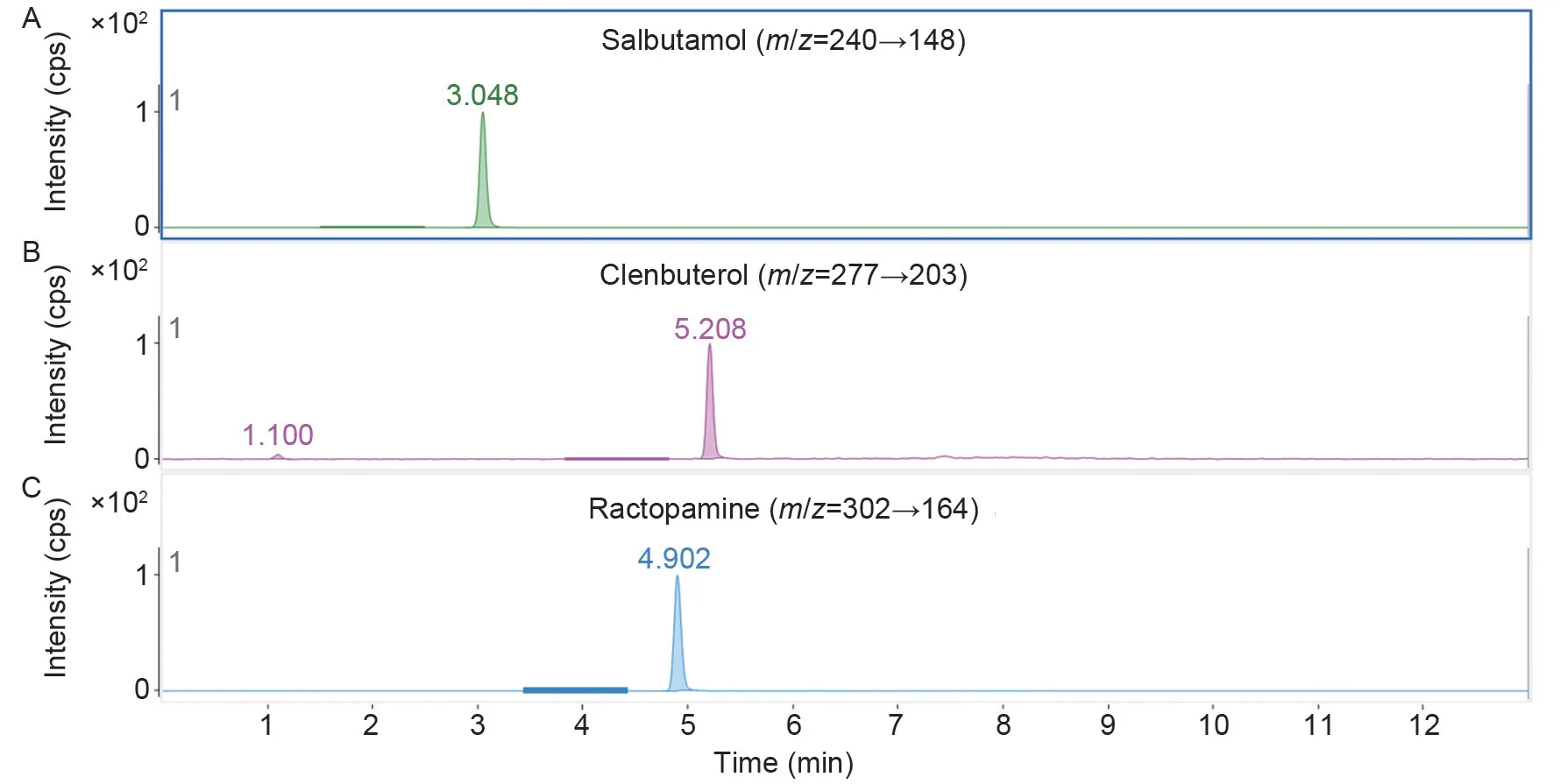
Fig.1 Chromatographic peaks of stock solutions.
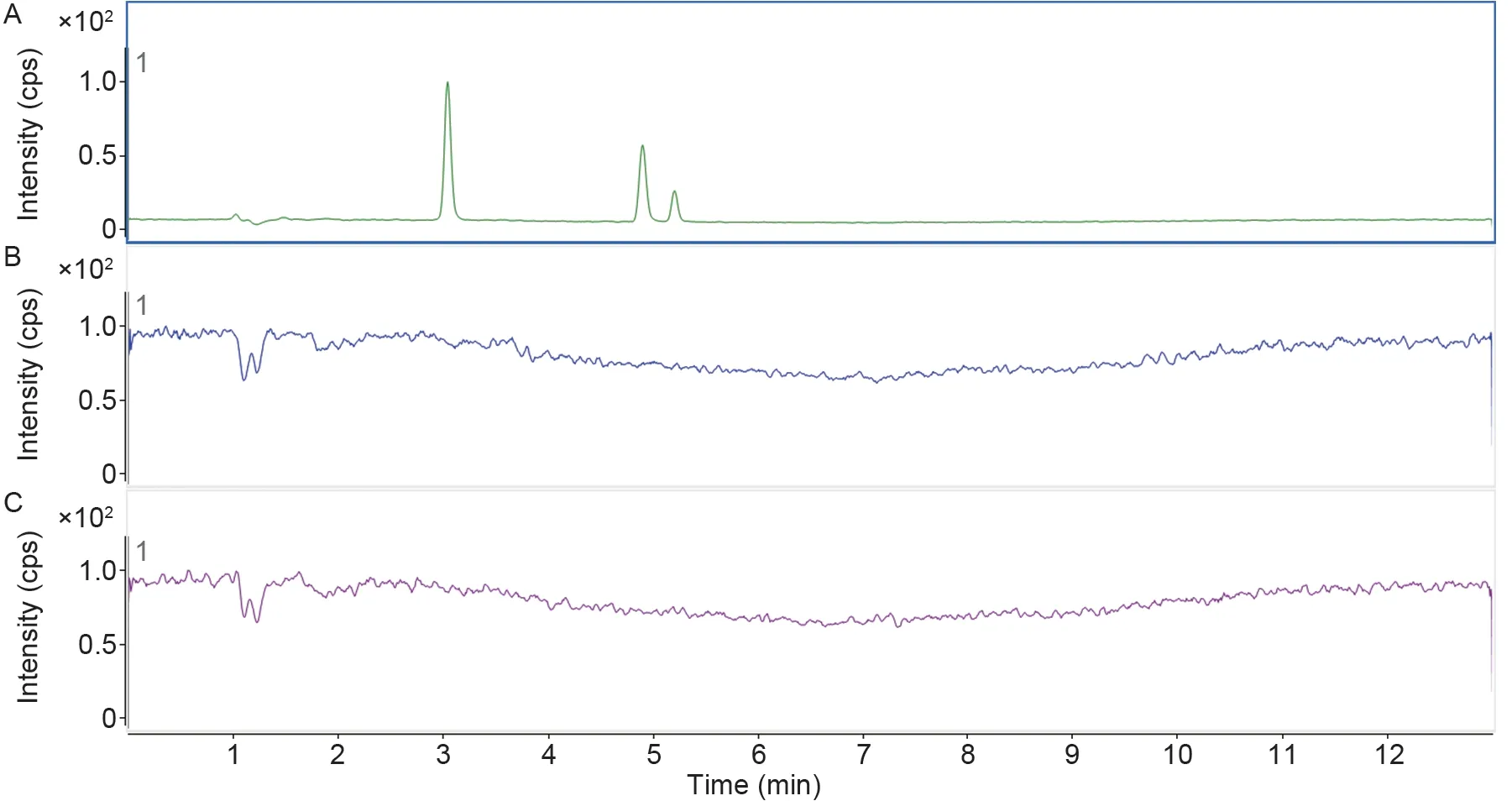
Fig.2 Total ion chromatograms of stock solutions (A) and urine from swine dosed with Citri Reticulatae Pericarpium Viride (B)and Citri Reticulatae Pericarpium (C).
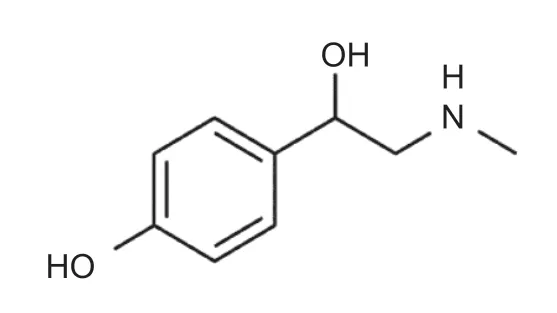
Fig.3 Chemical structure of synephrine (SYN).
This study confirmed that Citri Reticulatae Pericarpium Viride,Citri Reticulatae Pericarpium,Magnoliae Officinalis Cortex,Chaenomelis Fructus,and Rhodiolae Crenulatae Radix Et Rhizoma can cause false-positive CGIA results for CLB,RAC,and SALin vitro(TCM extracts),and Citri Reticulatae Pericarpium Viride and Citri Reticulatae Pericarpium can result in false-positive outcomesin vivo(swine urine). The results demonstrated that the falsepositive CGIA results were related to TCM use in swine feed,specifically Citri Reticulatae Pericarpium Viride and Citri Reticulatae Pericarpium.
Acknowledgements
This study was supported financially by the Guangdong Public Welfare Research and Capacity Building Project,China (2015A020209130).
Declaration of competing interest
The authors declare that they have no conflict of interest.
Ethical approval
All applicable internaltional,national and institutional guidelines for the care and use of animals were followed
杂志排行
Journal of Integrative Agriculture的其它文章
- Low glycemic index:The next target for rice production in China?
- Effect of side deep placement of nitrogen on yield and nitrogen use efficiency of single season late japonica rice
- Advancements in plant regeneration and genetic transformation of grapevine (Vitis spp.)
- Indica rice restorer lines with large sink potential exhibit improved nutrient transportation to the panicle,which enhances both yield and nitrogen-use efficiency
- Effects of nitrogen management on the ratoon crop yield and head rice yield in South USA
- Response of grain-filling rate and grain quality of mid-season indica rice to nitrogen application
